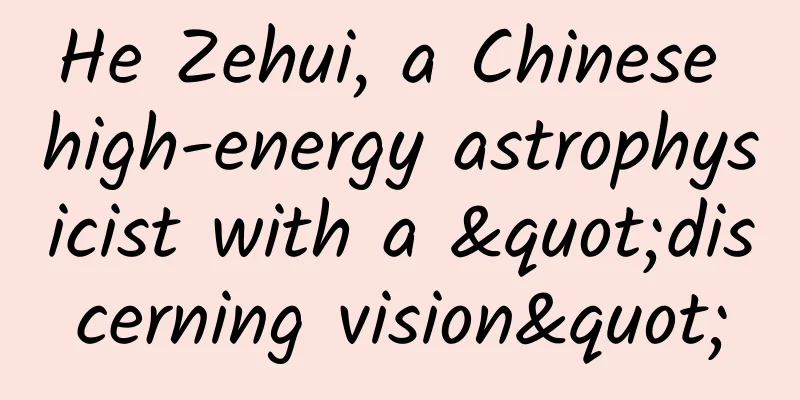He Zehui, a Chinese high-energy astrophysicist with a "discerning vision"

|
Being indifferent to fame and wealth will benefit future generations. The memory of wisdom and character will live forever. ——He Zehui, China’s first generation nuclear physicist On June 15, 2017, the Insight Hard X-ray Modulation Telescope was successfully launched in the form of a satellite at the Jiuquan Satellite Launch Center. This is China's first space X-ray telescope. Its name "Insight" not only implies that China has "unique vision" in space, but also commemorates He Zehui, a scientist who promoted the development of China's high-energy astrophysics. Image source: Xinhuanet He Zehui China's first generation of nuclear physicists She is the first female academician in China. She graduated from Tsinghua University in 1936. While working in France, she and her collaborators first discovered and studied the tri-fission and tetra-fission phenomena of uranium, which caused a great response in the international scientific community and was hailed as the "Chinese Marie Curie". After returning to China in 1948, she and her collaborators independently developed a particle-sensitive atomic nuclear latex detector and made important contributions in leading the construction of neutron physics laboratories, high-altitude cosmic ray observatories, and conducting research in high-altitude balloons, high-energy astrophysics and other fields. A well-born He Zehui was born in Suzhou, Jiangsu Province on March 5, 1914. Her father, He Cheng, was from Lingshi, Shanxi Province. He followed Sun Yat-sen in his early years and was a member of the Tongmenghui. During the 300 years of the Qing Dynasty, the He family produced 15 Jinshi and 29 Juren, so there is a saying in Shanxi that "there is no imperial examination without He". He Zehui is the third among 8 brothers and sisters. She was smart and clever since childhood and loved reading. At the age of 6, she entered Suzhou Zhenhua Girls' School (now Suzhou No. 10 Middle School, Jiangsu Province) founded by her grandmother Wang Xie Changda, and studied from the first grade of elementary school to high school graduation. He Zehui was very interested in physics when she was in middle school. This was also influenced by her family. Her uncle Wang Jile was a translator of physics works in the late Qing Dynasty and early Republic of China. He had an important influence and significant significance on the spread of modern physics in China. He Zehui's cousin Wang Shoujing was also a physicist who made great achievements in quantum mechanics. In such an open-minded and progressive family and school environment, He Zehui cultivated a spirit of self-respect and self-reliance since childhood and made a vow to devote herself to science. Study to save the country In 1932, 18-year-old He Zehui was admitted to the Department of Physics at Tsinghua University with excellent grades. However, due to the influence of traditional concepts at the time, professors in the Department of Physics believed that it was difficult for girls to achieve success in physics and advised them to change departments. However, He Zehui insisted on studying physics. The stubborn He Zehui not only insisted on staying in the Department of Physics, but also graduated with the first place in the class. The second place was Qian Sanqiang, a hero of the "Two Bombs and One Satellite" who later became her lifelong partner. In 1936, after graduating from Tsinghua University, He Zehui was frustrated in her job search because there were no jobs for women. He Zehui was not discouraged. She went abroad to study when she couldn't find a job in China, and she also served the country. Through the introduction of her classmate Wang Daheng, He Zehui found Kritz, the director of the Technical Department of the Berlin Higher Technical School in Germany, who had served as a consultant in the Nanjing Military Industry Bureau. At that time, the Anti-Japanese War had already broken out. He Zehui wanted to study ballistics out of patriotic enthusiasm, but was rejected by Professor Kritz again. This was a confidential department that not only did not accept women, but also foreigners. He Zehui said, "You can come to China to be a consultant for our Military Industry Bureau and help us fight the Japanese devils. I came here to study this major to fight the Japanese devils. Why don't you accept me?" Kritz was finally moved by He Zehui's patriotism and fortitude. The Department of Technical Physics made an exception to accept the first foreign student, and the ballistics major accepted the first woman. In 1940, He Zehui obtained her doctorate with the thesis "A New Accurate and Simple Method for Measuring the Speed of Bullets". At this time, World War II broke out and she could no longer return to China. In order to master more advanced science and technology useful to the country, she entered the weak current laboratory of Siemens Factory in Germany. In 1943, under the introduction of Professor Paschen, He Zehui went to the Institute of Nuclear Physics of the Royal Wilhelm Academy in Heidelberg to conduct nuclear physics research. In 1945, when He Zehui was studying the positron energy spectrum, she first observed the phenomenon of elastic collision between positrons and electrons, which was called "scientific treasure" by Nature magazine. After the outbreak of World War II, He Zehui learned that her former Tsinghua University classmate Qian Sanqiang was working at the Curie Laboratory of the University of Paris, France, so she wrote to Qian Sanqiang to ask about his safety. Due to the wartime, letters could not be sealed and were limited to 25 words. As their correspondence became more frequent, the two young people grew closer and closer. After more than two years of correspondence, in the spring of 1946, He Zehui left the Institute of Nuclear Physics of the Royal Wilhelm Academy in Heidelberg and came to post-war Paris with only a small suitcase. In the presence of the Joliot-Curies (the Curies), He Zehui and Qian Sanqiang got married. Study on the phenomenon of uranium nucleus fission, tri-fission and quad-fission He Zehui, who had done nuclear physics research in Germany for two years, successfully entered the Curie Laboratory of the University of Paris and became a colleague with Qian Sanqiang. They conducted in-depth research on nuclear fission. After several months of experimental analysis, they formally published a paper in early 1947, confirming the existence of uranium nucleus tri-fission and quad-fission. This important achievement caused a huge sensation in the international scientific community, so He Zehui and Qian Sanqiang were praised as "China's Curie couple." Study to Serve the Country In 1948, at the peak of their careers, He Zehui and Qian Sanqiang returned to their motherland with their six-month-old daughter. "At that time, we studied to work and never said we didn't want to come back," He Zehui said. "We went out to see the world and see how foreigners worked. We had to come back after completing our studies." After returning to China, Qian Sanqiang and He Zehui were ordered to build the Institute of Atomic Research of the Peking Academy of Sciences. It was the early days of the founding of New China, and there was a lot of work to be done. In addition, the imperialist blockade of China meant that there was not even the simplest experimental equipment. However, these difficulties did not stop them. He Zehui and Qian Sanqiang rode their bicycles every day to Beijing's second-hand goods market to find usable hardware equipment and electronic components, and used the renovated old machine tools to manufacture the instruments and equipment they needed. Under such simple experimental conditions, the research group led by He Zehui successfully mastered the preparation method of nuclear latex and developed nuclear latex with international advanced performance. In early 1955, He Zehui led the experimental preparation work for neutron physics and fission physics. In 1958, after the completion of China's first reactor and cyclotron accelerator, she served as the director of the Neutron Physics Laboratory, making important contributions to the development of China's neutron physics and fission physics experimental fields, and enabling China's fast neutron experimental work to quickly reach the international level at that time. In 1959, Soviet experts withdrew from China, and the central government urgently transferred some experts to supplement the atomic bomb research force. Due to various reasons, He Zehui did not join the core research team of "Two Bombs and One Satellite", but He Zehui did not fight or compete, and did not care about these titles, but only cared whether what she did was useful to the country. She still led a group of scientific researchers to cooperate with the work of "Two Bombs and One Satellite". They developed the ignition neutron source of the atomic bomb, and through hundreds of experiments, cracked the data loopholes in the development of the hydrogen bomb, avoiding detours in the development of the hydrogen bomb. The Nature of a Scientist In the winter of 1969, He Zehui and Qian Sanqiang were sent to the "May 7th" Cadre School in Heyang, Shaanxi. Due to poor health, He Zehui was arranged to ring the bell. Qian Sanqiang was very anxious and thought that being in the cadre school was a waste of time, but He Zehui was very open-minded, "Why worry, just leave it to fate." No matter what the situation was, He Zehui remained consistent in her tenacity and optimism, and rang the bell as seriously and accurately as she did her scientific research, not a second off, and the time of ringing the bell could be used to check the watch. In 1973, the Institute of High Energy Physics was established, and He Zehui served as the deputy director. She actively promoted the development of cosmic ray ultra-high energy physics and high energy astrophysics. With her advocacy and support, the Institute of High Energy Physics built the world's highest (5,500 meters) high-altitude latex chamber in Ganbala Mountain, Tibet; it also developed high-altitude scientific balloons from scratch and from small to large, and correspondingly developed space hard X-ray detection technology and other supporting technologies. He Zehui, who is now in her 80s, still cares about the motherland and the development of China's high energy physics and nuclear physics. In 2003, she proposed to relevant leaders to set up the HXMT satellite as soon as possible, which played a positive role in promoting the launch of the "Hui Yan" satellite. She has always advocated using simple experimental conditions to produce meaningful research results, and has always practiced it. The research directions she advocated are based on China's actual situation, making full use of all available conditions, and spending less money to do more. She once used "based on routine, focusing on novelty" as a summary of decades of scientific research practice experience. He Zehui often said, "I will do what is beneficial to the country - whether it is worthy of you or not." This is the true nature of a scientist, simple, real, hardworking, honest, and truthful. Different from her passion for science and persistent pursuit of truth, He Zehui is "not particular" about material life. When she was over 90 years old, she still took the bus from Zhongguancun to work at the Institute of High Energy Physics of the Chinese Academy of Sciences on Yuquan Road. She insisted on not asking the company to provide her with a car, and she ate casually. If it was late, she would buy a few buns and steamed buns in the cafeteria and drink some boiled water. Endless He Zehui and Qian Sanqiang jointly research academic issues On June 28, 1992, Mr. Qian Sanqiang, who had walked through life with He Zehui, passed away. In September 1999, the CPC Central Committee, the State Council, and the Central Military Commission awarded Qian Sanqiang the "Two Bombs and One Satellite Medal of Merit". Qian Sanqiang and He Zehui had been living in an old community built in the 1950s in Zhongguancun, Beijing. It was in sharp contrast to the bustling outside. Entering this community felt like a world away, as if time had frozen in decades ago. The dim and narrow corridors were covered with small advertisements for unclogging sewers. This was once home to China's "strongest brains", including eight winners of the "Two Bombs and One Satellite" Medal of Merit, and more than 60 academicians, many of whom were founders of the scientific cause of New China. This place can be said to be the root of the Zhongguancun spirit. The organization proposed several times to change her living conditions to better ones, but He Zehui politely declined. This old house has no decoration, no luxury items, and is filled with the fragrance of books. After Qian's death, the layout of the items in the house has hardly changed, and has always remained the same as when Qian Sanqiang was alive. Perhaps this is the best way for her to commemorate Qian Sanqiang. Since 2005, Premier Wen Jiabao has visited He Zehui six times and said, "Ms. He is a rare female scientist, a rare talent among men." He Zehui is a practitioner of the scientific tradition of academic and moral. She has not only made great achievements in academics, but also been a role model in morality. In the journey of scientific exploration, she has defended the dignity of science with her life; she loves her motherland and devotes herself to national defense research, first for the "resistance against Japan" and then for the "strengthening of the country"; she is indifferent to fame and fortune, does not fight or compete, and puts the interests of the country first; she is modest and low-key, simple and unpretentious, and is very frugal in both work and life. On June 20, 2011, the 97-year-old man passed away. This master who was respected by the world will be remembered forever. Author: Fu Xue Editor of scientific and technological journals, majoring in condensed matter physics, loves popular science, and has written many articles for popular science magazines and public accounts. Source: Damei Science Edit: 6000 Design: Akun Planning editor: Xiao Xuexue |
<<: What is it like to grow up in a hurry?
Recommend
Apple is accused of reducing iPhone 7 parts orders and lowering prices in the supply chain
August 24th marks the fifth anniversary of the da...
2018 Technology Company Atlas: The Birth and Fall of the Top Ten "Internet Celebrity" Apps
2018 was the year when mobile Internet fell from ...
Charm Academy "Top Wealth Thinking"
Charm Academy "Top Wealth Thinking" Res...
The Kitchen Adventures of "Mr. Bubble" - Why is there a "bubble party" when frying?
In the kitchen, we often encounter some mysteriou...
How to quickly increase the popularity of your live streaming room?
Live streaming has become a standard sales method...
4 questions about data-driven growth that you must know!
" Data-driven growth" began to be menti...
Yingke Huajiao was ordered to rectify its video live streaming business and faced three pitfalls
Nowadays, live video streaming is really popular....
Guangzhou suspends import of frozen meat and aquatic products from epidemic areas (full text)
According to the news released by Guangzhou on Au...
European, American, Japanese and Korean car companies are returning to Russia, and Chinese cars have been specifically banned from sale. Is there a strong connection between the two?
As the local situation gradually eases, European,...
Marketing Promotion丨Why can’t you sell the same product?
The product strengths are the same, why are other...
App promotion cheating insider series: machine brushing!
In the Android environment, machine brushing is t...
New research: Feeling stressed? It's because there's something wrong with the brain's reward mechanism!
In life, we often face various pressures. Some pe...
10 Valentine's Day copywriting pieces for your reference!
Valentine's Day is coming. Are you single or ...
Will the 2020 315 Gala still be held? CCTV 315 Gala Time Announced
Recently, some netizens discovered that the reser...









![[Grain Policy of a Great Country] How does AI understand biological breeding? We tested Deepseek](/upload/images/67f1c9f61ca73.webp)